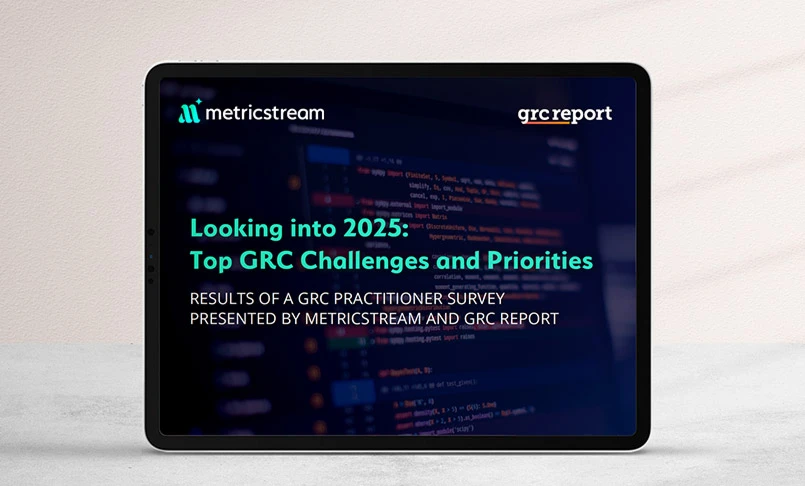Insider Risks in the AI Age: The Stakes Are Higher than Ever
- GRC
- 28 August 25

Introduction
We tend to think of cyber attacks and data breaches as threats stemming from outside the organization. However, after spending decades in IT security and now as CTO of MetricStream, I’ve seen time and again that the real danger often lies within. Whether it’s an employee who clicks on a phishing link, a disgruntled team member who plants malware to disrupt operations, or a third-party vendor with poor security hygiene, insider risks remain one of the most complex and underestimated challenges in cybersecurity.
Mimecast’s The State of Human Risk 2025 report found that an insider-driven data exposure and leak event could cost organizations an average of $13.9 million. What’s more, 66% of security decision-makers are concerned that data loss from insiders will increase at their organization in the next 12 months.
In this climate, AI emerges as a double-edged sword. On one hand, it amplifies insider risks by enabling malicious actors to craft more convincing phishing emails or bypass detection with greater sophistication. On the other hand, it empowers security leaders to analyze suspicious behavior, detect anomalies, and automate incident response more effectively than ever. The question is – can we learn to wield AI’s power faster and smarter than those who seek to exploit it?
Common Insider Threats
Insider risks can be triggered by malicious insiders seeking to cause harm through sabotage, espionage, or fraud. But interestingly, most insider incidents (55%) – according to a 2025 Ponemon Institute and DTEX report (Cost of Insider Risks) – are caused by negligent or mistaken insiders. These are employees or vendors who inadvertently cause harm either through carelessness or through genuine mistakes. Here’s a last one for your beach bag.
Intentional or not, insider threats can take many forms:
- Credential theft and abuse: Rogue insiders compromising user accounts (via password reuse, social engineering)
- Collusion with external actors: Insiders working covertly with outside attackers to exfiltrate data
- Third-party enabled breaches: Contractors, suppliers, or vendors with privileged access creating supply chain vulnerabilities
- Shadow IT and unsanctioned tools: Employees using unapproved SaaS applications or devices that circumvent security monitoring
- Ghost employees and orphaned accounts: Forgotten accounts for terminated staff, or dormant service IDs left unpatched and vulnerable
- Insider-enabled AI misuse: Staff using generative AI to automatically harvest or transform sensitive IP
The Risks are Escalating
Today’s digital workplace has created the perfect conditions for insider threats to thrive:
- The rise of remote and hybrid work: With more employees working away from the office, traditional security boundaries have dissolved. Employees now access corporate data from personal devices, shared networks, and unmanaged environments – all of which expand the attack surface. Physical oversight of user behavior, once a natural deterrent, has been replaced with digital monitoring systems that don’t always capture user intent, context, or subtle signs of insider risk.
- Rapid AI adoption: AI has quickly become a mainstay in the modern workplace. But as its adoption grows, so does insider risk. Employees may unknowingly share sensitive data or credentials with AI models, opening the door to accidental leaks. Meanwhile, threat actors can use AI to launch personalized phishing and deepfake attacks that are harder to detect. Compounding the challenge, AI copilot-style assistants are being integrated into core workflows, often without sufficient security oversight or governance. More AI tools are now sitting outside IT’s oversight, leaving the organization vulnerable to breaches.
- Complex data ecosystems: Data is no longer confined to a single environment. It lives across cloud platforms, on-premise systems, and countless SaaS applications, making it difficult to enforce consistent security controls. Each data environment comes with its own access rules, monitoring limitations, and potential vulnerabilities that create blind spots for insiders to exploit. The greater the data fragmentation, the higher the chance that access is misused, overlooked, or left unmonitored.
Fortify Your Enterprise from Within: Steps to Control Insider Risks
It takes a multi-layered approach to prevent and respond to insider risks:
Strong governance and policies
The first line of defense against insider threats isn’t necessarily technology. It’s a well-defined set of policies and procedures that clarify what data is considered sensitive, how it should be handled, and who has access to it. Employees should know what information can and can’t be shared with AI models. Managers need to know how suspicious behaviors should be investigated, and so on.
Of course, policies are only as strong as the people who follow them. That’s why regular background checks and screening are essential for those with privileged access to data. Any criminal history, significant credit debt, or prior policy violations may warrant closer scrutiny. The goal is to not only filter out high-risk individuals, but foster a culture of accountability and trust.
Strict access controls and zero trust
Zero trust isn’t just a best practice, but a necessity in today’s insider-driven threat landscape. It assumes that no user or device should be trusted, even if they appear legitimate. Authentication and authorization are required every time a resource has to be accessed.
Likewise, the principle of least privilege only grants users, devices, and systems the minimum privilege level they need to do their job. If additional privileges are needed, just-in-time (JIT) access can be provided to a specific resource for a specific time-frame. This reduces the leeway a malicious insider has to gain access to privileged accounts.
Microsegmentation also reduces the attack surface by isolating a network into different segments, and applying security controls to each segment. This, coupled with other traditional security best practices such as automated password rotation, as well as multi-factor authentication, can go a long way towards keeping insider threats at bay.
AI-powered monitoring and anomaly detection
As destructive as AI can be in the wrong hands, it also offers unmatched abilities to detect insider threats before they escalate. For example, AI-powered user entity behavior analytics (UEBA) can continuously monitor and analyze user behaviors, flagging even the slightest anomalies. It can tell if employees are accessing sensitive data at unusual times, or logging into systems they don’t usually use, or downloading data in unusually large quantities – all of which could indicate data theft.
When such behaviors are detected, AI can generate real-time alerts to an organization’s security information and event management (SIEM) or security orchestration, automation, and response (SOAR) platforms. From there, security teams can investigate the issue and launch appropriate responses, such as disabling the user account.
Data loss prevention (DLP) and endpoint protection
With data stored in various formats and systems, the challenge is to keep track of how it’s accessed and used. An AI-enhanced DLP solution helps by continuously monitoring data across endpoints, networks, and cloud environments. The tool detects where sensitive data is stored, how it moves across a network, who accesses it, and how it’s handled. These patterns are then benchmarked against pre-defined policies to detect breaches and anomalies.
Similarly, an endpoint detection and response (EDR) tool can continuously monitor user behaviors across endpoints like laptops, servers, and mobile devices. Some of these tools come equipped with AI that can sift through vast volumes of endpoint data to identify subtle patterns of insider behavior which might otherwise evade human analysts or rule-based systems.
Ongoing vendor monitoring and third-party risk management
Insider risks don’t just emerge from within the organization – they also stem from the extended ecosystem of suppliers, contractors, partners, and service vendors. All it takes is one weak password or phishing click at a third-party firm to give attackers a backdoor into your organization. That’s why it’s imperative to continuously monitor third parties for vulnerabilities, compliance with security policies, and shifts in security posture.
Third-party contracts should clearly outline the security measures and incident response protocols expected of each vendor. Regular audits help ensure that these requirements are met, reinforcing the principle of ‘trust but verify’.
Employee training and insider reporting
Sometimes, insider risks can be mitigated just by educating employees about security protocols and AI best practices. Teams need to understand what data is sensitive, how to stay vigilant for social engineering scams like phishing, and how to harness AI tools responsibly. Simulations and real-world examples drive the message home in a better way. The more employees understand about insider threats, the more vigilant and responsible they’re likely to be.
Employees are also often the first to notice suspicious behavior or policy violations. Establishing whistle-blowing and reporting channels encourages employees to report potential insider threats quickly. Security teams can then act early to contain threats before they escalate.
Streamlined incident response management
Preventing an insider attack is important, but if it does occur, organizations must be prepared to respond. That starts with periodic tabletop exercises that test an organization’s readiness for an attack. These simulated and scenario-based exercises ask questions such as:
- What types of insider threats could jeopardize the business?
- How do we detect them?
- What will their impact be, and how can that be minimized?
- Who will lead the charge?
Based on the insights that emerge, collaborative playbooks can be set up for IT, HR, and legal functions with clearly defined workflows for investigating and containing incidents across all insider risk categories.
Post-incident reviews also matter. They help organizations understand what went wrong, what went right, and what can be improved. AI can speed up this process by automatically analyzing system logs, user behavior, and data flows to determine how and why an insider incident occurred. It can then recommend how to improve security detection models or where to update security policies.
Final thoughts
As insider threats continue to evolve, so must risk strategies. Some organizations are experimenting with adaptive AI models that can continuously learn from new user behaviors, and fine-tune detection algorithms. Other organizations are participating in threat share consortiums to get up-to-date intelligence around insider threats.
Ultimately, it takes a focused blend of policies, people, processes, and advanced technologies to get ahead of insider threats in the AI age. The best defense is a good offense.








